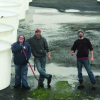 INSTITUTE FOR NATURAL RESOURCES
INSTITUTE FOR NATURAL RESOURCESYou are here
TOPICS
all

Aquaculture is the breeding, rearing and harvesting of fish, shellfish, plants, algae, and other organisms in fresh or salt water.

Aquaculture is the breeding, rearing and harvesting of fish, shellfish, plants, algae, and other organisms in fresh or salt water.

Aquaculture is the breeding, rearing and harvesting of fish, shellfish, plants, algae, and other organisms in fresh or salt water.

Aquaculture is the breeding, rearing and harvesting of fish, shellfish, plants, algae, and other organisms in fresh or salt water.

Aquatic mitigation seeks to balance alterations made to our aquatic resources with protecting functions such as controlling floodwater, filtering pollution and providing natural habitats for plants and animals.

Biodiversity is the variety of life, and the processes that support it, encompassing species and their genetic variation.

Biodiversity is the variety of life, and the processes that support it, encompassing species and their genetic variation.

Birds are the most diverse group of vertebrates in Oregon, with over 400 species known, found in all habitats across the state.

The Oregon Century Farm and Ranch Program, has honored the state's rich agricultural heritage since 1958. It awards farm and ranch families that have maintained connections to the land for 150 and 100 years.

Climate change refers to long-term change in global or regional climate patterns, especially a change in the average atmospheric temperature. Changes in Oregon's climate are affecting the state's natural and human systems.

Coastal hazards may be catastrophic such as earthquakes or tsunamis, or chronic, such as coastal erosion, landslides, windthrow and flooding.










